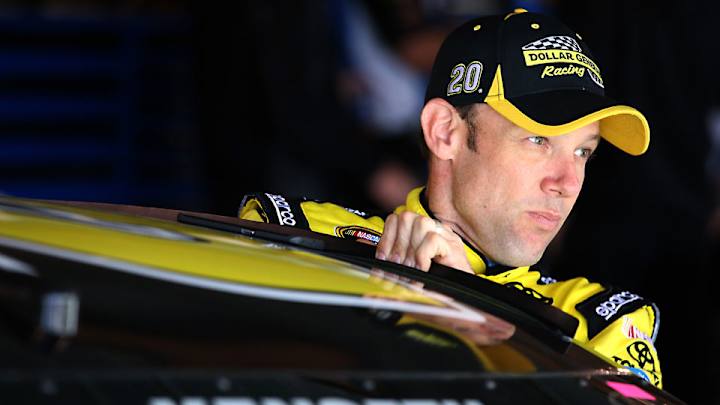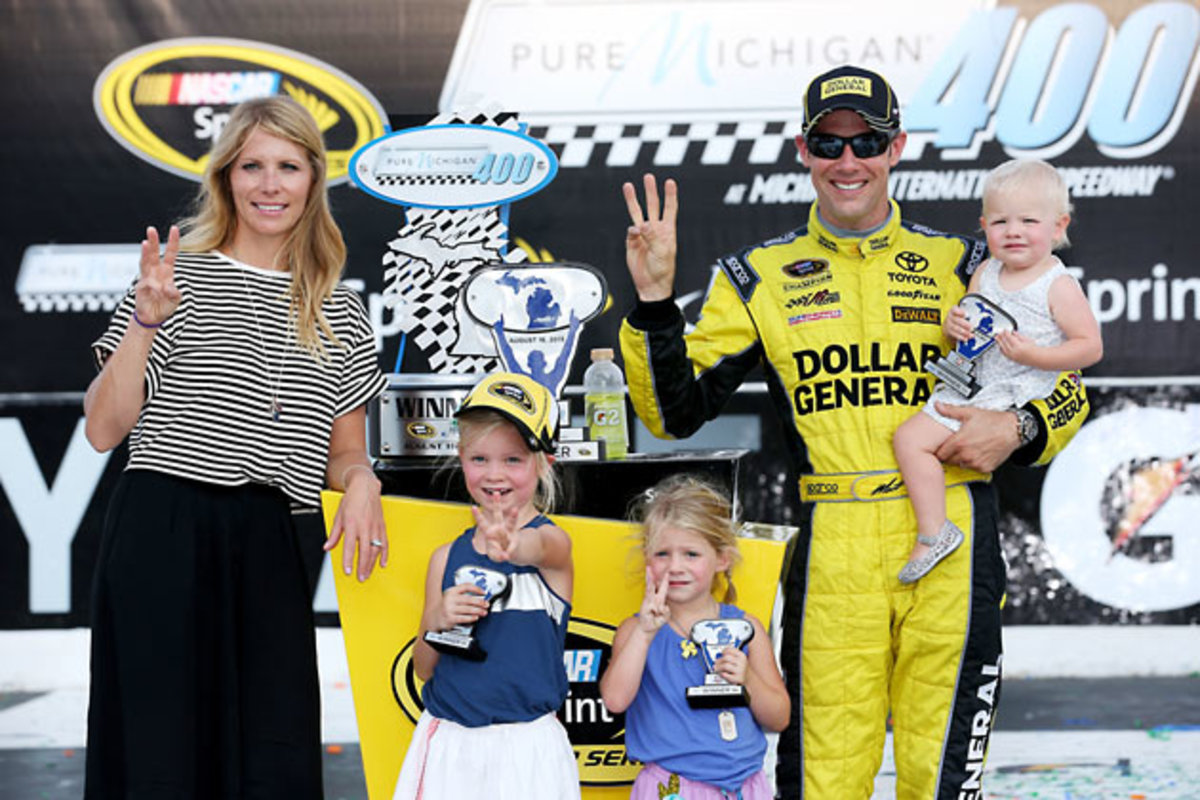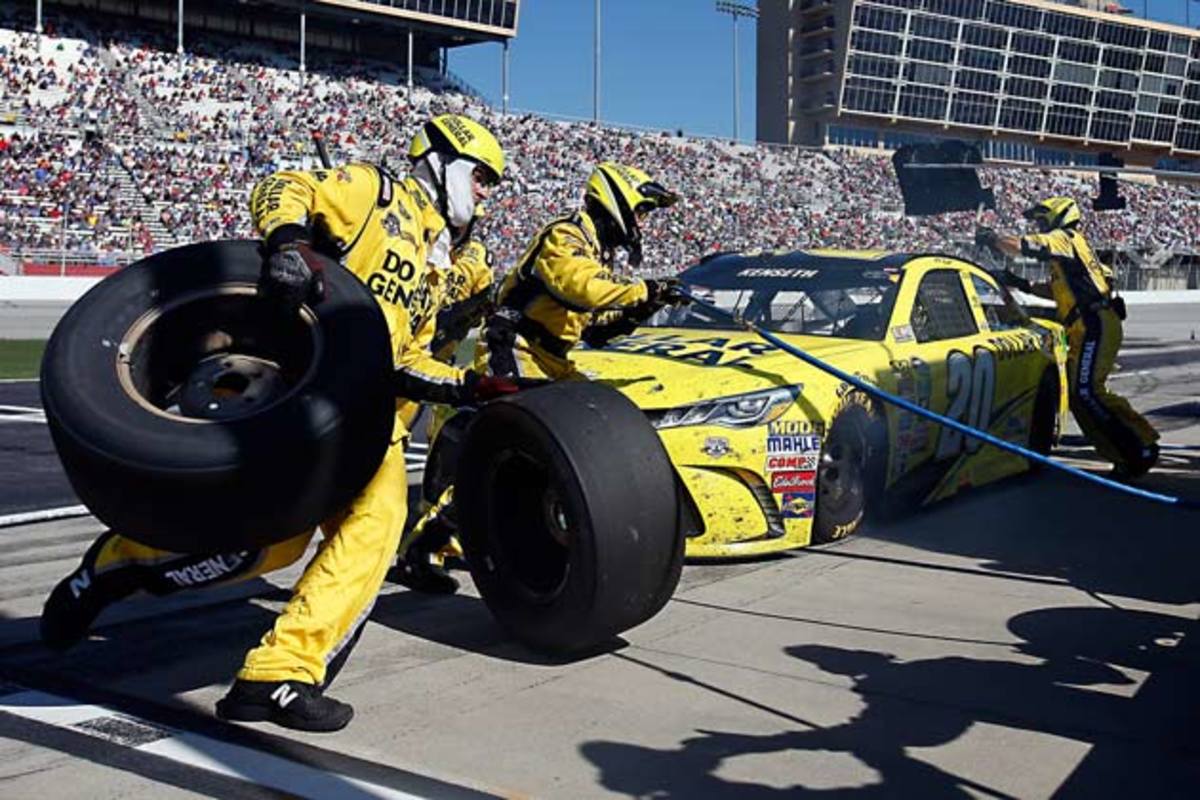NASCAR's Matt Kenseth battling run of hard luck

Eight months ago, before a NASCAR Sprint Cup race in Indianapolis, Matt Kenseth was hanging out in his motorcoach with the eldest of his three young daughters—a precocious six-year-old named Kaylin. She has the firmest grasp of what daddy does for a living, asks a ton of questions. She’s always wanting to know who finished last, who won and, naturally, where her daddy wound up—although she’s hardly as results-driven as his employer, Joe Gibbs Racing. “I could finish ninth,” says the 44-year-old Kenseth, “and she’ll be like, ‘Daddy, great job finishing ninth! I could do the worst job in the world, and my girls’d figure out a way to make me feel a little bit better about it.’”
Kaylin’s always wanting to know who’s going to win. Before the Indy race she prodded her old man for yet another prediction. Kenseth, though, wasn’t especially inclined to pick himself. After all, he’s from Wisconsin. (And humblebragging is a criminal misdemeanor in the Midwest, isn’t it?) Also, he had notched only one victory in his last 63 starts to that point—a fruitless streak that can be hell on a man’s confidence.
So you can imagine what an out-of-body experience it was for Kenseth to hear himself say to his little towhead, “You know what, Kaylin? I really think we’re gonna win this weekend!”
Here’s the thing about kids: With knowledge comes terrifying bluntness. Kaylin, bless her, can’t be anything but unsparing. “No dad, seriously,” she deadpanned, “who do you think is gonna win?”
“Seriously,” Kenseth insisted, despite never, in 15 tries, having grabbed a checkered flag at the Brickyard. “I think we’re gonna. I feel like this might be our weekend!”
“Seriously dad, who..?”
On and on this went until duty mercifully called Kenseth back to the track, where he ultimately brought the No. 20 car home in seventh. So, no, his prediction did not come to pass that weekend. But his Spidey sense that his team was on the cusp of flush times again was not altogether wrong. The very next weekend he won at Pocono, then again two weeks later at Michigan, then yet again three weeks after that in the NASCAR regular-season finale at Richmond. This made for quite a bit of daddy-daughter time in Victory Lane. “It definitely makes the celebration more fun,” Kenseth says.

With four wins in his column, a total only his JGR teammate Kyle Busch had matched to that point, Kenseth stamped himself as a favorite to win the Cup championship—something he’d only done once before, in 2003, well before Kaylin and her sisters were born. In fact, after posting a fifth win in the second Chase race at Loudon, it seemed as if Kenseth might cruise. But then in the second-round transfer race at Kansas, his fortunes turned. (Or were they pushed? Let’s circle back to this later …)
In 2016, hard luck has followed Kenseth like so much wake turbulence. In each of his six races to date he hasn’t just finished worse than he’s started (with an average position of 18.5 versus 8.8), but in the flukiest ways too. The baffling streak began at Daytona. There Kenseth led with a half lap left until he memorably moved up the track to block his charging teammate Denny Hamlin and spiraled, on older rubber, down to 14th. (“I let my team down,” Kenseth said afterward.)
His next race in Atlanta was an even bigger disaster. After a so-so qualifying (13th), Kenseth rallied to lead 47 laps and position himself for a win. But then a third of the way through the race, he was slapped with a flagrant foul—a black flag. Really, it was a team foul, a ticky-tack citation for an illegal pit stop. In a bid to shave a few tenths off the service time, Kenseth’s fueler dropped a wrench off for another crewmember before topping off the No. 20 car.
The move, a textbook timesaver, was interpreted as unsafe according to the latest edition of the rulebook. What’s more, it was just the sort of move that NASCAR’s two-year-old pit road monitoring system was designed to target. If the system has a blind spot, though, it’s that it doesn’t make it easy for folks on the ground to challenge these findings—what with so many pit road officials hiding in the race tower nowadays.
Still, Jason Ratcliff, the No. 20 car’s undeterred crew chief, found someone to get into an argument with anyway. While he made his point, Kenseth kept circling the hot, slick track unawares, the setting sun washing out his view of the flag stand. By the time word reached him in the cockpit, his penalty had snowballed into a two-lap deficit—which doomed him to a 19th-place finish. “Obviously, if you had to do it over,” says Kenseth, “you’d just bite the bullet whether you agree with the penalty or not, serve it and continue on.”

It seemed as if he’d get off the schneid in Las Vegas—where he had won three times before, in 2013 most recently for Gibbs. But while running fifth with 43 laps to go Kenseth fishtailed the No. 20 car on a restart, got rear-ended by rookie Chase Elliott and finished 37th.
Then of course two weeks later there was Martinsville, the latest of Kenseth’s tough losses. This after he had seemingly improved his chances of victory by uniting with his Gibbs teammates in a kind of gentlemen’s agreement—not an uncommon occurrence there, where the bottom groove is tackiest. “When teammates are running 1-2,” explains Steve Letarte, a Cup crew chief turned NBCSN analyst, “they know that the outside is a non-preferred groove.” So the leader takes it and the second-position car, on the inside, holds up traffic until the leader overtakes him. “That allows the teammates to stay first and second and both have the line at the bottom,” Letarte continues. “And why that works very, very well is when you get to the end of the race, the rows behind you have the opportunity to really push the issue into turn one and perhaps even make contact to move people up the racetrack.”
The Gibbs pilots, who have been willing collaborators all season (at Daytona, most notably), made a deal to hold off on their internecine rivalry until there were 10 laps left. “I’ve got just awesome teammates that work hard to not only win races on their own, but if they can’t win they want a JGR car to win,” says Kenseth. “We always try to help each other if we can without hurting our own effort.”
At the 11 to-go mark Kenseth was in the ideal spot, running second to Busch heading into a final restart. But instead of easing down the road, to the low groove, Kenseth remained stranded on the inferior line up top while Busch tucked in on the left-hand side. When the green flag flew again, Busch sped off while Kenseth struggled to fall in behind and was quickly swallowed up by the pack. Busch claimed the checkers. Kenseth finished 15th.
Not that he has any hard feelings about it. “It’s not expected or required to ever help during the race,” says Kenseth, still well above the Chase cutoff—14th on the leader board. “You’re the leader. You work hard to be the leader. It’s your prerogative to start in whichever lane you want. Kyle, he’s good at restarts. Obviously I wish I would’ve gotten a better start and could’ve been on the bottom. But when you look at it we were right on him probably getting ready to pass him when the caution came out. The smarter thing to do to try to win the race was not to put the car you think’s a little better than yours right behind you.”
This brand of perspective is typical of Kenseth, one of the sport’s true gentlemen. Never mind that a pair of fang-bearing incidents has turned him into something of a heel. In the first he jumped Brad Keselowski after a 2014 Chase race in Charlotte. In the second, which occurred at Martinsville just five months ago, he T-boned race leader Joey Logano right out of the Chase—an apparent payback strike for Logano wiping him out two races earlier in Kansas. (So it wasn’t just bad luck there, then …)
Not surprisingly, the track referenced that 2015 incident often while drawing a crowd to the ’16 race. This despite the fact that Kenseth was parked for two races after going HAM. The irony of this didn’t upset him much, though. The track promoter was doing what he had to do, just as Kenseth had in the heat of battle. “I think that you try to respect your competitors and race a certain way, and you hope to get that same treatment back,” he says. “But when conditions on the ground change, you’ve gotta be able to change with that. You can’t be a doormat.
“Last year I felt like I got ran over and taken out of the Chase. And if you just smile and shrug it off and continue about your business, what’s going to stop somebody different from doing it the next race? Or the next year? There’s always a point where you’ve gotta make the decision: Am I going to stop this? How am I gonna stop this? Is there a way we can reason this out and understand? Was it partially my fault? Do we need to come together, come up with a conclusion? What do you need to do?
“Nobody likes to be in those spots. You never want to be doing those things. You always want to get along with everybody the very best you can, race as fair as you can. But like I say, there’s also that time at that place where you’ve gotta put your foot down and be like, enough’s enough.”
He’s likewise had it with the losing streak that ensued and still endures. He hopes to put a stop to it this weekend at Texas. Still, even though he is a two-time winner there, he remains even-keeled about his chances. “I probably don’t have the confidence that I had going there three or four years ago,” he says. “But I really like the track, and I look forward to the challenge of trying to get it all put together.”
No, his season hasn’t gone according to plan. But that’s only because expectations for him are sky high to begin with. “If you took the same results and gave em to Paul Menard,” says Letarte, “you’d probably call it a good year. There are a lot of expectations on the No. 20 because his teammate [Busch] is the defending champion, because the No. 11 [Hamlin] won the Daytona 500. But the most important part of any equation is speed, and the No. 20 has that.”
Kenseth also has an uncanny knack for shrugging off complications and staying the course—a trait that will always keep him in title contention. And in the unlikely event he strays? He’s got his real-talking daughter Kaylin, easily his most honest critic, to put him back in place. Seriously.
